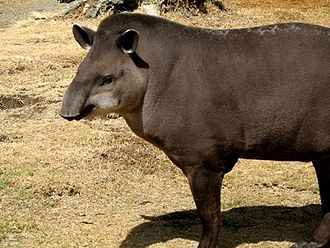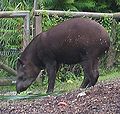Tapir
Tapirs are odd-toed ungulates form the family Tapiridae. The only living genus is Tapirus. The first tapirids appeared in the Eocene epoch, and by the Oligocene they looked similar to the present-day species. For much of their history, tapirs were spread across the Northern Hemisphere extinct as recently as 10,000 years ago.[1]
| Tapir | |
|---|---|

| |
| Brazilian tapir | |
| Scientific classification | |
| Kingdom: | |
| Phylum: | |
| Class: | |
| Order: | |
| Family: | Tapiridae Gray, 1821
|
| Genus: | Tapirus Brünnich, 1772
|
Taxonomy
- Family Tapiridae
- Brazilian tapir or Lowland tapir (Tapirus terrestris)
- Mountain Tapir (Tapirus pinchaque)
- Baird's tapir (Tapirus bairdii)
- Malayan tapir (Tapirus indicus)
- Kabomani tapir (Tapirus kabomani)
Appearance
Tapirs are about 2 m / 7 ft long and about 1 meter / 3 ft high. They weigh between 150 - 300 kg / 330 - 700 lb. They have a rounded body and very short stubby tails. Tapirs have hoofed toes, with four toes on the front feet and three toes on the hind feet. The Tapir's upper lip and nose have formed a short trunk, and they have a long tongue.
Tapirs have a short fur, with colors that are reddish-brown to grey to nearly black. Exceptions are the Mountain Tapir and the Asian Tapir. The Mountain Tapir has longer wooly fur. The Asian Tapir has a black front part and legs, and a white middle part and back. All baby tapirs have brown fur, with lighter stripes and dots for camouflage.
Tapirs cannot see very well, but they have good hearing and a very good sense of smell. Tapirs also swim very well.
Habitat
Tapirs live in of South America and Central America, except the Asian Tapir which lives in Southeast Asia. Tapirs live in dense forests, and close to water. They can also live in savannah biomes, or in dry tropical deciduous forests near a permanent water source.[2]
Life
Tapirs are active at night. They eat leaves, fruit, berries, vegetables and nuts.
Tapirs live alone. After a pregnancy of about 13 months, the female gives birth to a single baby. After half a year the baby starts to lose the baby-coloring of its fur. When the young tapir is one year old it looks like an adult tapir, and it leaves its mother. Tapirs become mature when they are 4 years old. Tapirs can become 25 – 30 years old.
Gallery
Tapir Media
(video) A tapir at Ueno Zoo
References
- ↑ Palmer D. (ed) 1999. The Marshall illustrated encyclopedia of dinosaurs and prehistoric animals. London: Marshall Editions, p. 261. ISBN 1-84028-152-9
- ↑ Jirik, Kate. "LibGuides: Tapirs (extant/living species; Tapirus spp.) Fact Sheet: Distribution & Habitat". ielc.libguides.com. Retrieved 2023-11-07.
Other websites
| Wikispecies has information on: Tapiridae. |
| Wikimedia Commons has media related to Lua error in Module:Commons_link at line 62: attempt to index field 'wikibase' (a nil value).. |












